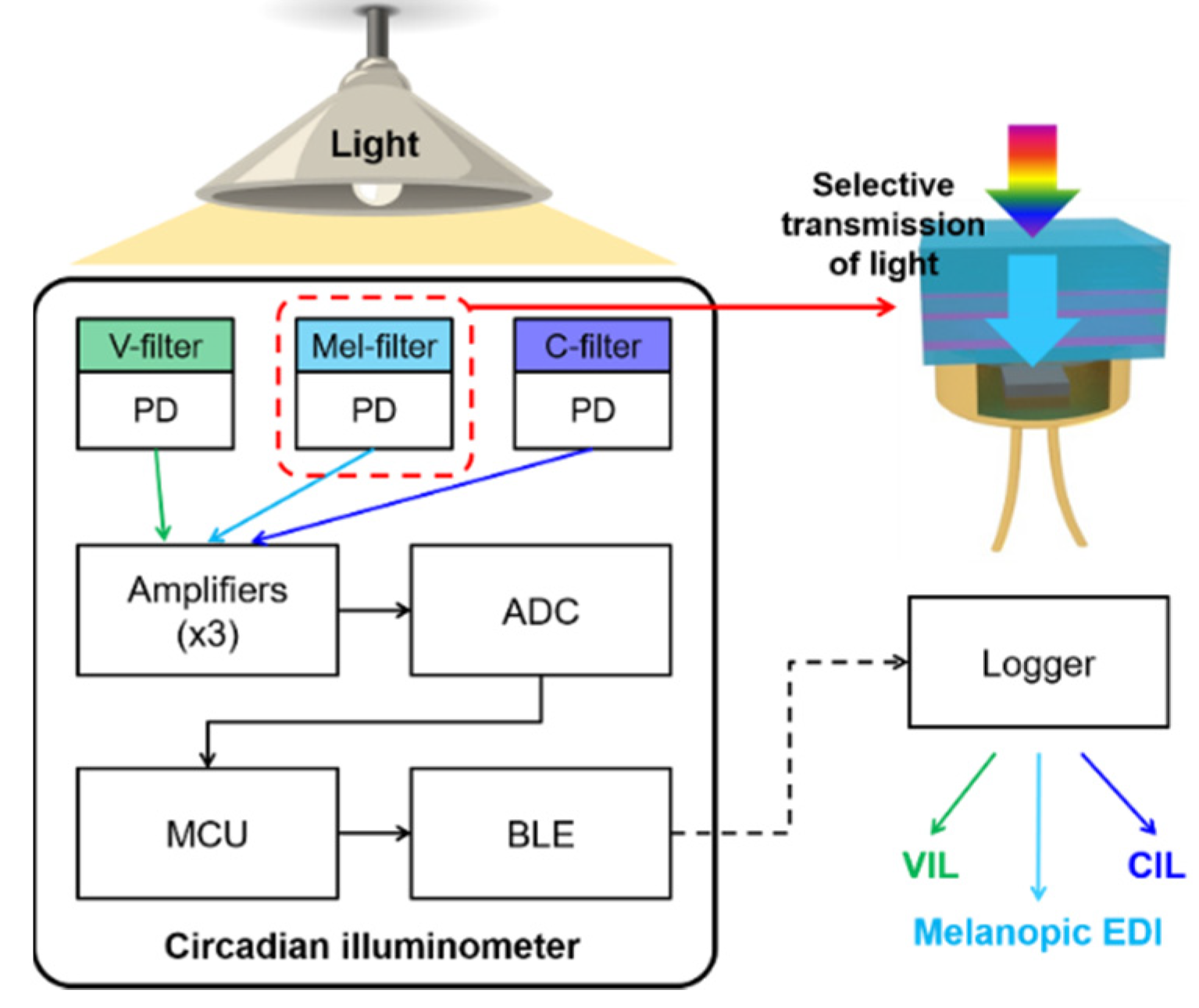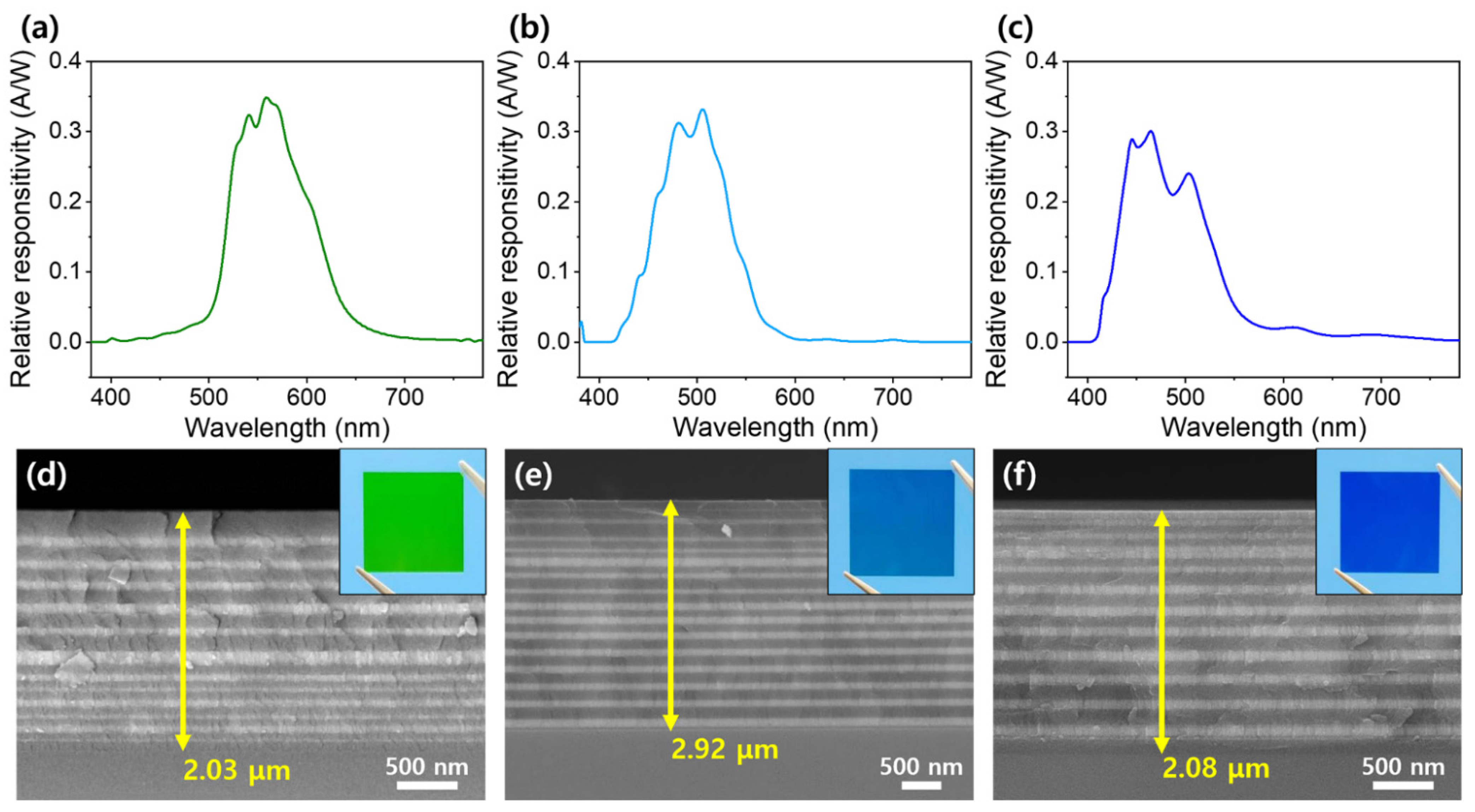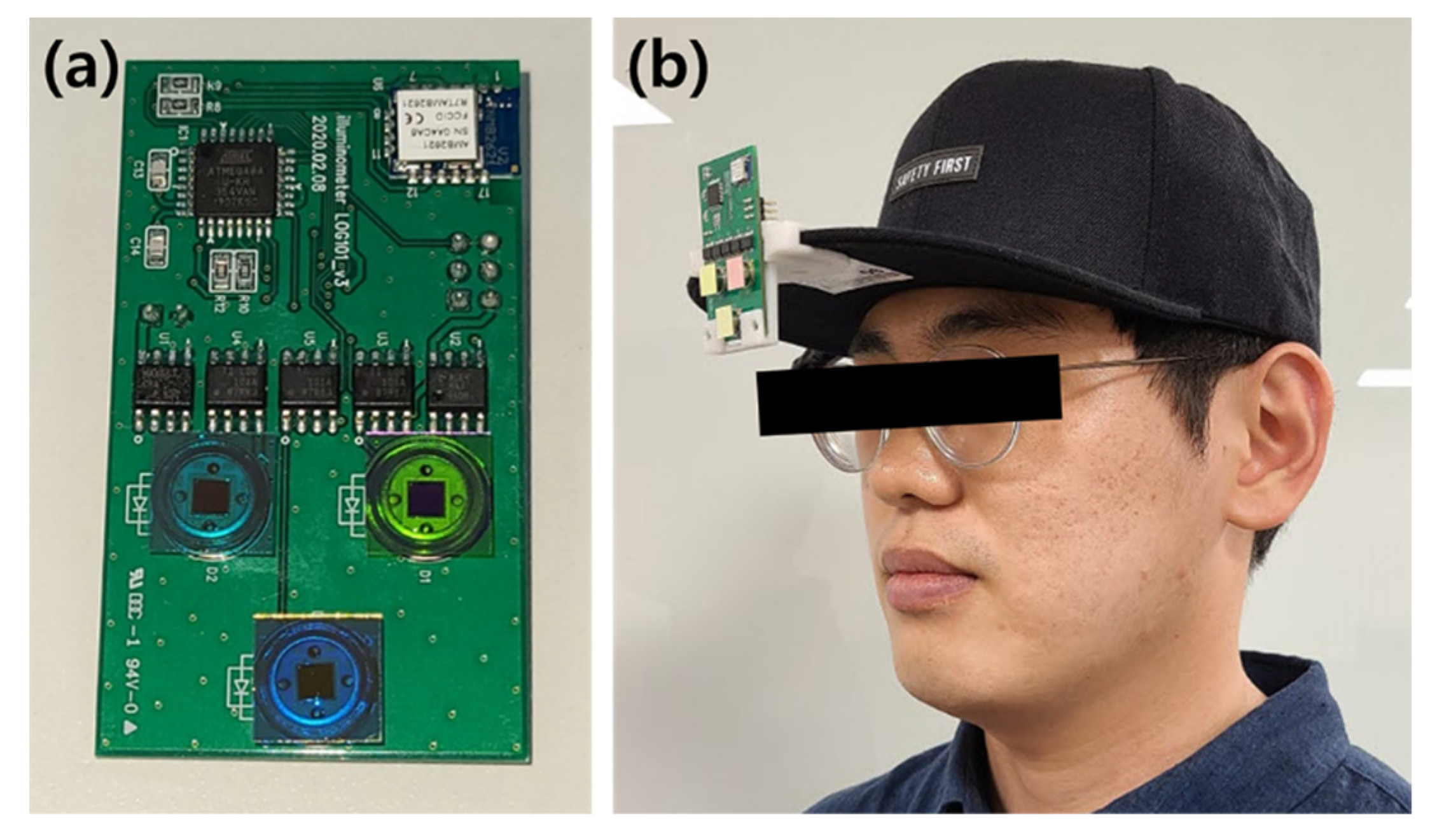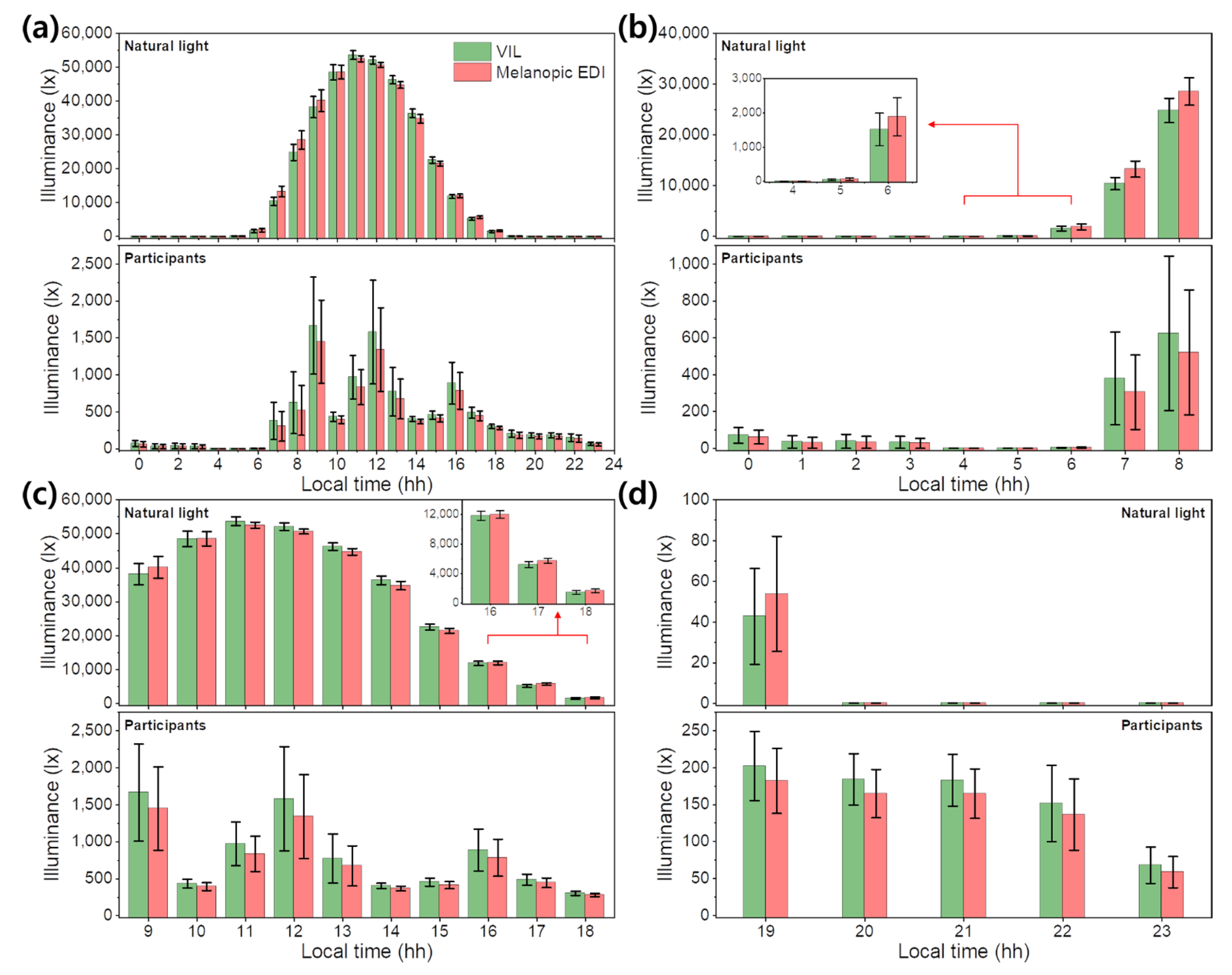Fabrication of Circadian Light Meter with Non-Periodic Optical Filters to Evaluate the Non-Visual Effects of Light on Humans
Abstract
:1. Introduction
2. Materials and Methods
2.1. Preparation of the Optical Filter
2.2. Fabrication of the Circadian Light Meter
2.3. Evaluation of the Circadian Light Meter
2.4. Measuring the Light Exposure of the Participants
3. Results
3.1. Optical Filters Capable of Selective Light Transmission
3.2. Verification and Reproducibility of the Circadian Light Meter
3.3. Analyzing Illuminance Levels to Which the Participants Were Exposed
4. Discussion
5. Conclusions
- To directly measure the three types of illuminance values, optical filters that mimic the corresponding functions were simulated and fabricated. The percentage spectral mismatches of the V-, Mel-, and C-filters were 7.27%, 7.67%, and 7.74%, respectively. Because the transmittance spectra of the optical filters mimic the respective action spectrum, an identical method can be applied to measure other types of illuminance not mentioned in this study.
- The circadian light meter was manufactured using a simple circuit with a single gain resistor and a log-scale amplifier, and can measure illuminance over a wide range from approximately 0.1 to 50,000 lx. However, the f1′ of the VIL measurement channel recorded 13.1%. In particular, the f2 of the VIL, melanopic EDI, and CIL channel were 24.4%, 22.2%, and 25.9%, respectively, so further improvement of off-axis irradiance is required.
- The measured melanopic EDI and CIL values differed only slightly depending on the optical filter used. While a non-standard CIL was used in this study to allow a simple comparison with the CIE standard melanopic EDI, but it was not clear whether the spectral resolution of the filters used could distinguish the difference between the two illuminances. In other words, the circadian light meter can be further simplified and miniaturized to measure only the melanopic EDI.
- Using the circadian light meter, it was quantitatively confirmed that the participants lived in a light environment with very low illuminance levels compared to natural light during the daytime: the maximum VIL and melanopic EDI values of natural light were 53,609 ± 1280 lx and 52,511 ± 888 lx, respectively, while those values of the light exposed to the participants were 1580 ± 702 lx and 1342 ± 567 lx, respectively. These considerable differences have the potential to disturb the circadian rhythm.
- Although additional tightly controlled clinical and physiological studies on the non-visual effects of light and circadian rhythm are necessary, nevertheless, the circadian light meter has a potential to be a useful tool to enhance and maintain an individual’s circadian rhythm. In addition, if the circadian light meter is commercialized at a reasonable price, it may be valuable in large-scale field studies considering the individual’s sensitivity to blue light and its effects on melatonin levels and changes.
Supplementary Materials
Author Contributions
Funding
Institutional Review Board Statement
Informed Consent Statement
Data Availability Statement
Conflicts of Interest
References
- Roorda, A.; Williams, D.R. The arrangement of the three cone classes in the living human eye. Nature 1999, 397, 520–522. [Google Scholar] [CrossRef]
- Macros, S.; Moreno, E.; Navarro, R. The depth-of-field of the human eye from objective and subjective measurements. Vis. Res. 1999, 39, 2039–2049. [Google Scholar]
- Nakamura, S.; Senoh, N.; Iwasa, N.; Nagahama, S. High-brightness InGaN blue, green and yellow light-emitting diodes with quantum well structure. Jpn. Appl. Phys. 1995, 34, L797–L799. [Google Scholar] [CrossRef]
- Weisbuch, C.; Piccardo, M.; Martinelli, L.; Iveland, J.; Peretti, J.; Speck, J.S. The efficiency challenge of nitride light-emitting diodes for lighting. Phys. Status Solidi A 2015, 212, 899–913. [Google Scholar] [CrossRef]
- Longcore, T.; Rich, C. Ecological light pollution. Front. Ecol. Environ. 2004, 2, 191–198. [Google Scholar] [CrossRef]
- Scheer, F.A.; Czeisler, C.A. Melatonin, sleep, and circadian rhythms. Sleep Med. Rev. 2005, 9, 5–9. [Google Scholar] [CrossRef] [PubMed]
- Khan, S.; Malik, B.H.; Gupta, D.; Rutkofsky, I. The role of circadian misalignment due to insomnia, lack of sleep, and shift work in increasing the risk of cardiac diseases: A systematic review. Cureus 2020, 12, e6616. [Google Scholar] [CrossRef] [Green Version]
- Stevens, R.G. Circadian disruption and breast cancer. Epidemiology 2005, 16, 254–258. [Google Scholar] [CrossRef]
- Dai, Q.; Cai, W.; Shi, W.; Hao, L.; Wei, M. A proposed lighting-design space: Circadian effect versus visual illuminance. Build. Environ. 2017, 122, 287–293. [Google Scholar] [CrossRef]
- Dupláková, D.; Flimel, M.; Duplák, J.; Hatala, M.; Radchenko, S. Ergonomic rationalization of lighting in the working environment. Part I.: Proposal of rationalization algorithm for lighting redesign. Int. J. Ind. Ergon. 2019, 71, 92–102. [Google Scholar] [CrossRef]
- Dupláková, D.; Hatala, M.; Duplák, J.; Knapčíková, L.; Radchenko, S. Illumination simulation of working environment during the testing of cutting materials durability. Ain Shams Eng. J. 2019, 10, 161–169. [Google Scholar] [CrossRef]
- Brainard, G.C.; Hanifin, J.P.; Greeson, J.M.; Byrne, B.; Glickman, G.; Gerner, E.; Rollag, M.D. Action spectrum for melatonin regulation in humans: Evidence for a novel circadian photoreceptor. J. Neurosci. 2001, 21, 6405–6412. [Google Scholar] [CrossRef] [Green Version]
- Thapan, K.; Arendt, J.; Skene, D.J. An action spectrum for melatonin suppression: Evidence for a novel non-rod, non-cone photoreceptor system in humans. J. Physiol. 2001, 535, 261–267. [Google Scholar] [CrossRef]
- Rea, M.S.; Figueiro, M.G.; Bierman, A.; Hamner, R. Modelling the spectral sensitivity of the human circadian system. Lighting Res. Technol. 2012, 44, 386–396. [Google Scholar] [CrossRef]
- Rea, M.S.; Nagare, R.; Figueiro, M.G. Modeling circadian phototransduction: Quantitative predictions of psychophysical data. Front. Neurosci. 2021, 15, 44. [Google Scholar] [CrossRef]
- Oh, J.H.; Yang, S.J.; Do, Y.R. Healthy, natural, efficient and tunable lighting: Four-package white LEDs for optimizing the circadian effect, color quality and vision performance. Light Sci. Appl. 2014, 3, e141. [Google Scholar] [CrossRef]
- Lucas, R.J.; Peirson, S.N.; Berson, D.M.; Brown, T.M.; Cooper, H.M.; Czeisler, C.A.; Figueiro, M.G.; Gamlin, P.D.; Lockley, S.W.; O’Hagan, J.B.; et al. Measuring and using light in the melanopsin age. Trends Neurosci. 2014, 37, 1–9. [Google Scholar] [CrossRef] [PubMed]
- CIE S 026/E:2018. CIE System for Metrology of Optical Radiation for ipRGC-Influenced Responses to Light; CIE: Vienna, Austria, 2018. [Google Scholar]
- Bierman, A.; Klein, T.R.; Rea, M.S. The Daysimeter: A device for measuring optical radiation as a stimulus for the human circadian system. Meas. Sci. Technol. 2005, 16, 2292–2299. [Google Scholar] [CrossRef]
- Figueiro, M.G.; Hamner, R.; Bierman, A.; Rea, M.S. Comparisons of three practical field devices used to measure personal light exposures and activity levels. Lighting Res. Technol. 2013, 45, 421–434. [Google Scholar] [CrossRef]
- Rea, M.S.; Bullough, J.D.; Figueiro, M.G. Phototransduction of human melatonin suppression. J. Pineal Res. 2003, 32, 209–213. [Google Scholar] [CrossRef] [PubMed]
- Yoo, G.R.; Azmi, R.; Kim, C.; Kim, W.; Min, B.K.; Jang, S.Y.; Do, Y.R. Stable and colorful perovskite solar cells using a nonperiodic SiO2/TiO2 multi-nanolayer filter. ACS Nano 2019, 13, 10129–10139. [Google Scholar] [CrossRef]
- Lee, S.; Yoo, G.Y.; Kim, B.; Kim, M.K.; Kim, C.; Park, S.Y.; Yoon, C.H.; Kim, W.; Min, B.K.; Do, Y.R. RGB-colored Cu(In,Ga)(S,Se)2 thin-film solar cells with minimal efficiency loss using narrow-bandwidth stopband nano-multilayered filters. ACS Appl. Mater. Interfaces 2019, 11, 9994–10003. [Google Scholar] [CrossRef]
- ISO/CIE 19476:2014. Characterization of the Performance of Illuminance Meters and Luminance Meters; ISO/CIE: Vienna, Austria, 2014. [Google Scholar]
- Price, L.L.A.; Lyachev, A.; Khazova, M. Optical performance characterization of light-logging actigraphy dosimeters. J. Opt. Soc. Am. A 2017, 34, 545–557. [Google Scholar] [CrossRef]
- DIN 5032-7. Photometry-Part 8: Classification of Illuminance Meters and Luminance Meters; DIN: Berlin, Germany, 2016. [Google Scholar]
- Lockley, S.W.; Evans, E.E.; Scheer, F.A.J.L.; Brainard, G.C.; Czeisler, C.A.; Aeschbach, D. Short-wavelength sensitivity for the direct effects of light on alertness, vigilance, and the waking electroencephalogram in humans. Sleep 2006, 29, 161–168. [Google Scholar] [PubMed]
- Gabel, V.; Maire, M.; Reichert, C.F.; Chellappa, S.L.; Schmidt, C.; Hommes, V.; Viola, A.U.; Cajochen, C. Effects of artificial dawn and morning blue light on daytime cognitive performance, well-being, cortisol and melatonin levels. Chronobiol. Int. 2013, 30, 988–997. [Google Scholar] [CrossRef] [Green Version]
- Garfinkel, D.; Laudon, M.; Nof, D.; Zisapel, N. Improvement of sleep quality in elderly people by controlled-release melatonin. Lancet 1995, 346, 541–544. [Google Scholar] [CrossRef]
- Redwine, L.; Hauger, R.L.; Gillin, J.C.; Irwin, M. Effects of sleep and sleep deprivation on interleukin-6, growth hormone, cortisol, and melatonin levels in human. J. Clin. Endocrinol. Metab. 2000, 85, 3597–3603. [Google Scholar] [CrossRef]
- Gradisar, M.; Wolfson, A.R.; Harvey, A.G.; Hale, L.; Rosenberg, R.; Czeisler, C.A. The sleep and technology use of Americans: Findings from the National Sleep Foundation’s 2011 sleep in America poll. J. Clin. Sleep. Med. 2013, 9, 1291–1299. [Google Scholar] [CrossRef]
- Partonen, T. Effects of morning light treatment on subjective sleepiness and mood in winter depression. J. Affect Disord. 1994, 30, 99–108. [Google Scholar] [CrossRef]
- Dowling, G.A.; Mastick, J.; Colling, E.; Carter, J.H.; Singer, C.M.; Aminoff, M.J. Melatonin for sleep disturbances in Parkinson’s disease. Sleep Med. 2005, 6, 459–466. [Google Scholar] [CrossRef] [PubMed]
- Zeitzer, J.M.; Dijk, D.J.; Kronauer, R.E.; Brown, E.N.; Czeisler, C.A. Sensitivity of the human circadian pacemaker to nocturnal light: Melatonin phase resetting and suppression. J. Physiol. 2000, 526, 695–702. [Google Scholar] [CrossRef] [PubMed]
- Lockley, S.W.; Brainard, G.C.; Czeisler, C.A. High sensitivity of the human circadian melatonin rhythm to resetting by short wavelength light. J. Clin. Endocrinol. Metab. 2003, 88, 4502–4505. [Google Scholar] [CrossRef] [PubMed]
- Kim, C.; Yoon, H.C.; Kim, D.H.; Do, Y.R. Spectroscopic influence of virtual reality and augmented reality display devices on the human nonvisual characteristics and melatonin suppression response. IEEE Photonics J. 2018, 10, 3900911. [Google Scholar]





| Conventional Light Meter (CL-500A) | Circadian Light Meter (This Work) | |||||
|---|---|---|---|---|---|---|
| VIL (lx) | Melanopic EDI 1 (lx) | CIL 1 (lx) | VIL (lx) | Melanopic EDI (lx) | CIL (lx) | |
| White LED (6500 K) | 985.2 ± 0.7 (0.0007) | 847.6 ± 0.6 (0.0007) | 880.2 ± 0.6 (0.0007) | 983.5 ± 2.8 (0.0029) | 841.5 ± 9.1 (0.0109) | 874.5 ± 6.7 (0.0077) |
| Halogen lamp | 113.7 ± 0.5 (0.0041) | 17.6 ± 0.3 (0.0151) | 19.1 ± 0.3 (0.0141) | 122.0 ± 0.6 (0.0053) | 19.9 ± 0.3 (0.0144) | 20.7 ± 0.3 (0.0143) |
Publisher’s Note: MDPI stays neutral with regard to jurisdictional claims in published maps and institutional affiliations. |
© 2021 by the authors. Licensee MDPI, Basel, Switzerland. This article is an open access article distributed under the terms and conditions of the Creative Commons Attribution (CC BY) license (https://creativecommons.org/licenses/by/4.0/).
Share and Cite
Eo, Y.J.; Kim, S.; Lee, K.N.; Kim, D.H.; Kim, C.; Lee, S.M.; Do, Y.R. Fabrication of Circadian Light Meter with Non-Periodic Optical Filters to Evaluate the Non-Visual Effects of Light on Humans. Appl. Sci. 2021, 11, 8283. https://doi.org/10.3390/app11188283
Eo YJ, Kim S, Lee KN, Kim DH, Kim C, Lee SM, Do YR. Fabrication of Circadian Light Meter with Non-Periodic Optical Filters to Evaluate the Non-Visual Effects of Light on Humans. Applied Sciences. 2021; 11(18):8283. https://doi.org/10.3390/app11188283
Chicago/Turabian StyleEo, Yun Jae, Seohyeon Kim, Keyong Nam Lee, Dae Hwan Kim, Changwook Kim, Seung Min Lee, and Young Rag Do. 2021. "Fabrication of Circadian Light Meter with Non-Periodic Optical Filters to Evaluate the Non-Visual Effects of Light on Humans" Applied Sciences 11, no. 18: 8283. https://doi.org/10.3390/app11188283
APA StyleEo, Y. J., Kim, S., Lee, K. N., Kim, D. H., Kim, C., Lee, S. M., & Do, Y. R. (2021). Fabrication of Circadian Light Meter with Non-Periodic Optical Filters to Evaluate the Non-Visual Effects of Light on Humans. Applied Sciences, 11(18), 8283. https://doi.org/10.3390/app11188283






